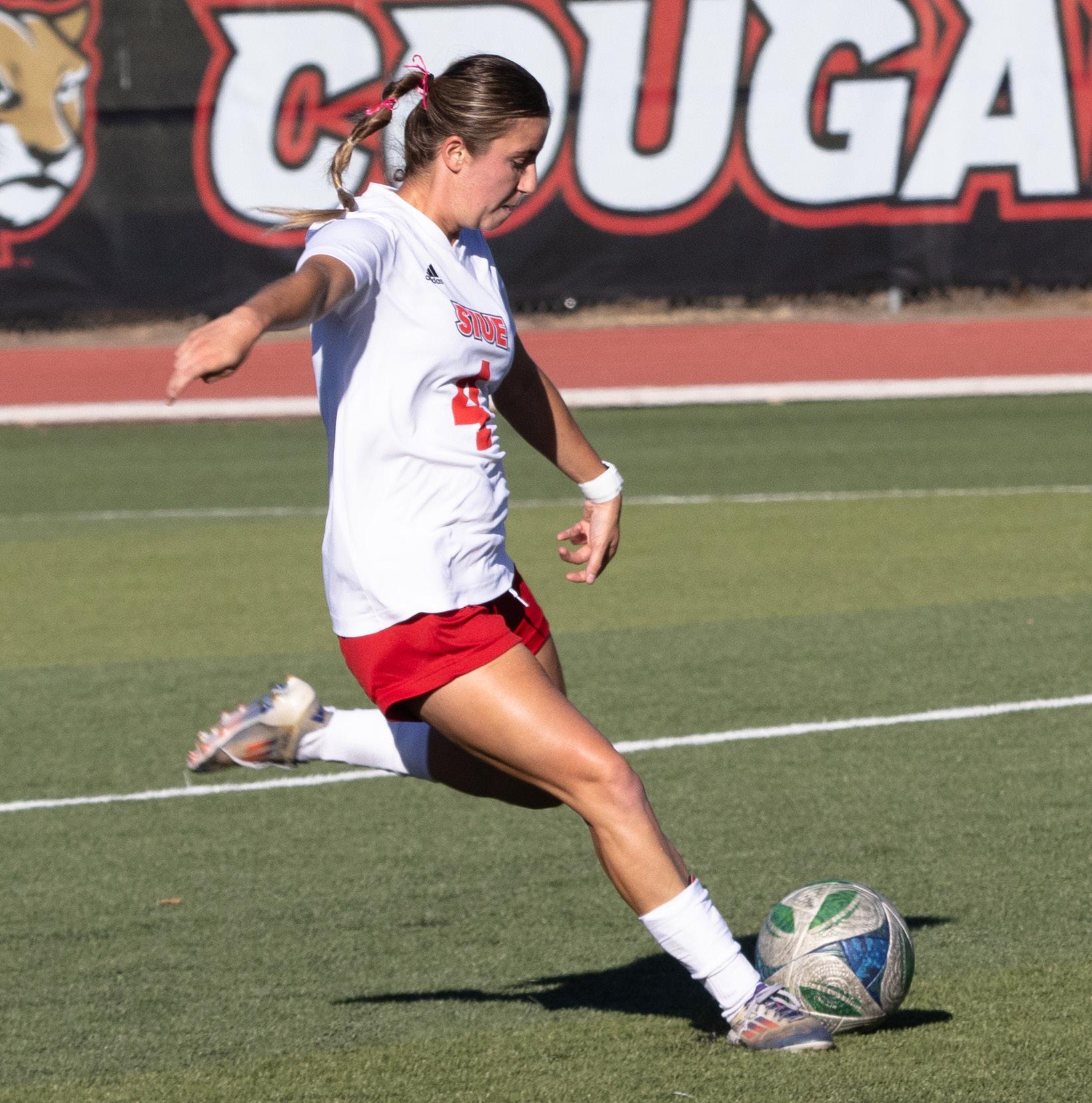‘WORN THIN’ ‘WORN THIN’



Lecturers stressed as high enrollment places pressure on general education requirement
BRANDI SPANN opinion editor
In response to high enrollment numbers this fall, academic departments with general education courses had to drastically adjust their practices to accommodate the number of students that needed to take these classes.
With new sections being added, lecturers hired at the last minute and with larger class sizes, students now have less time to learn the material. Some instructors feel that they are stretched thin and that administration is not acknowledging the impact
that enrollment has had on their faculty and staff.
Professor and Chair of Applied Communications Studies Eric Duff Wrobbel said that hiring was a “mad scramble” at the end of the summer, and he attributed their success to “luck.”
“If the folks that are doing enrollment management are doing a bang-up job, but that information isn’t getting disseminated to those of us that have to accommodate all those extra students, then that creates these last-minute challenges,” Duff said.
Matthew Johnson, director
courses
of first-year writing and professor of English said that the department is delighted by the influx of students, and that they hope it continues. But, the lack of acknowledgment that “ground level” university employees receive for their contributions to this increase is harmful to morale.
“The first-year writing teachers are fairly close-knit. We talk. We exchange assignments, and we exchange pedagogical strategies. And you can see this semester, people are worn thin,” Johnson said. “When that enrollment happens so quickly, so last-minute, it creates challenges
‘We don’t feel valued’
for the department in terms of morale when we see praise to the chancellor, the vice chancellor for enrollment management and the vice chancellor for student affairs without recognizing the enormous amount of effort that will happen elsewhere.”
“I’m concerned for the firstyear writing teachers. These are primarily non-tenure track faculty members. But of course, this affects Housing, this affects Advising, this affects Counseling. So, yes, it’s something to be celebrated, but the enormous challenges are something to be recognized,” Johnson said.

Despite the pressure placed on departments, Director of Undergraduate Admissions Samantha Ray said that the enrollment increase is intentional and that her office does not find the influx of students to be a challenge.
“For us, more numbers is exciting. It’s not necessarily a challenge or a concern,” Ray said. “We’ve got the resources to support this, or this wouldn’t have been our goal.”
Applied Communications Studies 103: ‘A juggling act’
Duff said Academic Advising tends to push first-year students to take ACS 103: Interpersonal Communication Studies during the fall semester.
“The problem, then, is I have to have so much staff in the fall to cover all of that, but I don’t have any work left in the spring,” Duff said.
Duff maxed out his lecturers’ workloads, and he even had to hire two more lecturers and max out their workloads as well.
“I had to go back to my own faculty and ask if one or two of them would be willing to take overloads, and we had to over-enroll 10 sections of the class way past their normal capacity. So, it’s really been just a crushing see ENROLLMENT on page 3
Building service workers speak out about workplace culture
GAVIN QUINLAN
reporter
SIUE’s building service workers are feeling unsatisfied with their workplace environment as understaffing, lack of administrative support and increased reliance on student workers remain prominent issues.
Although BSWs secured greater bargaining power last year with the creation of AFSCME Local 2887, a single union representing all SIUE employees, BSWs are still struggling to obtain the workplace conditions they desire.
“When I got here, we didn’t have a contract,” BSW Todd Lohr said. “Negotiations were going on, so of course that wasn’t the best of times … [The work culture] was kind of bad when I started, and it hasn’t gotten any better … We don’t feel valued.”
Some full-time BSWs said they generally feel supported by their supervisors, but cited upper management as the source of Facilities Management’s problems. The position of director of Facilities Management has been vacant since Craig Holan retired in April.
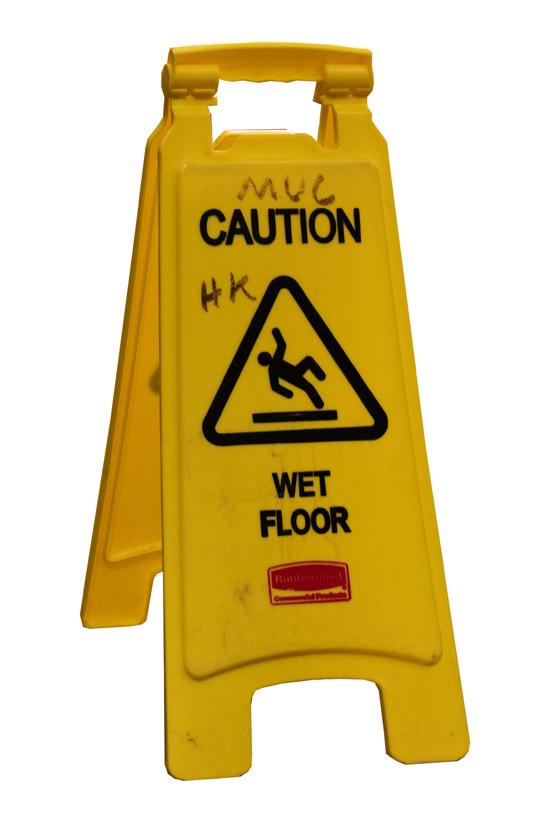
“We are, in my opinion, understaffed, and there is no hope on the horizon for fixing it,” one BSW, who wished to remain anonymous due to fear of retaliation from administration,
said. “[There used] to be a little bit more camaraderie amongst all the workers, and we seemed to have managerial support … [It] doesn’t seem to be there [anymore]. I’m not talking about my immediate supervisors … I think they are as frustrated as we are.”
With many vacancies in Facilities Management, the anonymous BSW said, workers are facing heavier workloads for no additional compensation.
“[Administration is] making things so miserable for people out here that the people that have been here for a while that know how things are supposed to be leave,” the anonymous BSW said. “[They’re] doubling the work, [but] pay’s not increased or anything like that.”
Some BSWs are concerned about the lack of union representation and vulnerability to worker exploitation that may come with an increase in student workers.
“I know that [student workers] have not been talked to at all about joining a union, if there is one,” the anonymous BSW said.
Former grounds worker and BSW Binam Pandey said that while the workload is manageable and the environment is decent, communication with supervisors and union officials is lacking for student workers like himself.
“In grounds, we had to [communicate] a lot of things with the supervisor and other full-time workers. Here, so far in building services, I haven’t talked to anyone like that,” Pandey said.
Lohr said that past attempts to integrate student workers into technical work, such as mixing cleaning chemicals, have been blocked due to union contracts.
“[Managers] were using students to do more of what the [full-time] building
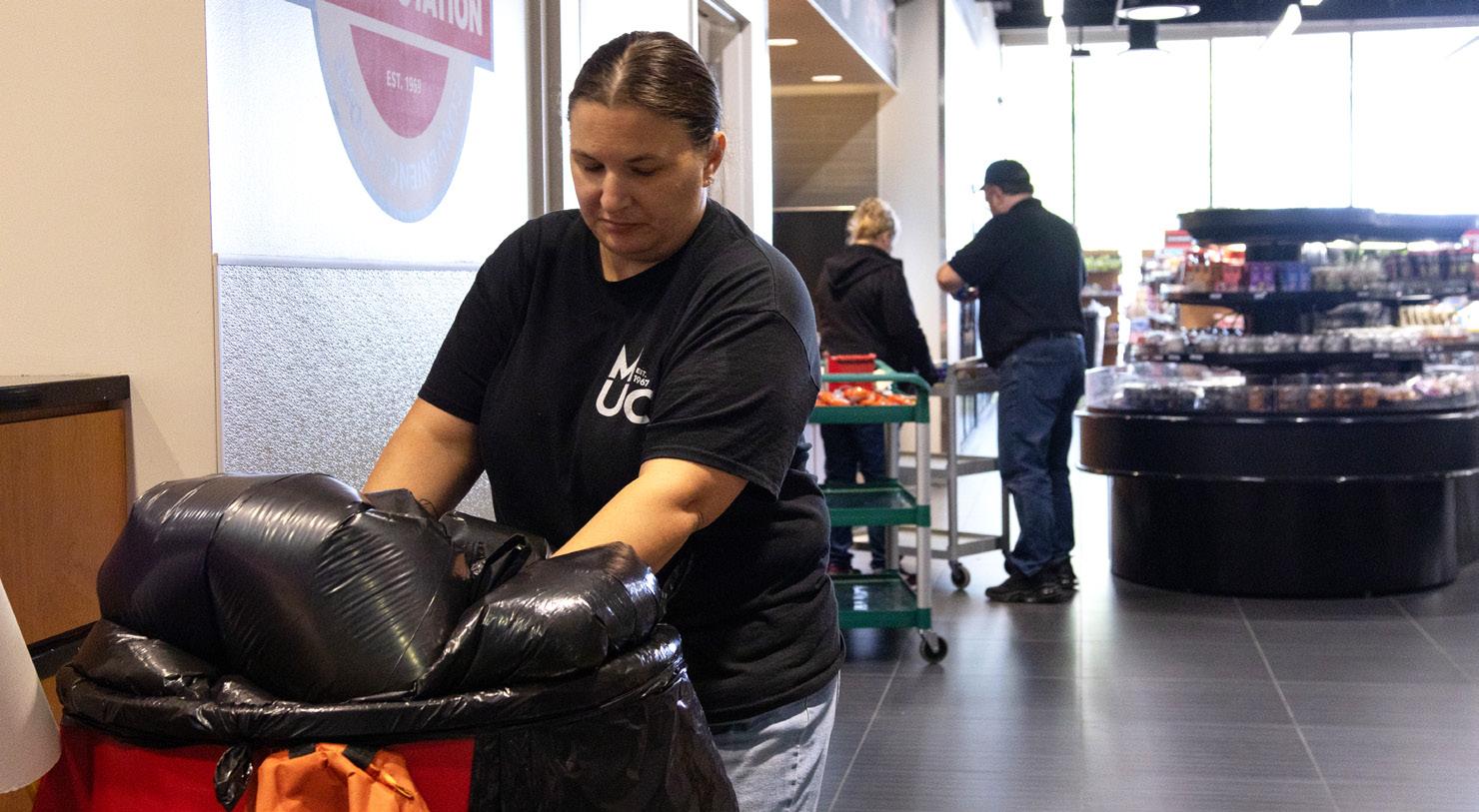
| Gavin Rask / The Alestle
service workers usually did,” Lohr said. “They were wanting student workers to do bathrooms … It really shouldn’t be that way. [Management] should read the contract, know what the rules are and go by them.”
Not only do BSWs fear for student workers, but for the employment of fulltime workers as well.
“The more they do our [full-time BSWs’] job, the more we’re expendable,” Lohr said. “It really shouldn’t be just students doing the job. They’re here to learn. This is a university.”
While BSW Zachary Wisniewski finds the work environment welcoming and friendly, he said that union membership is still an important and thoroughly explained part of his job.
“[Union stewards] have explained quite a lot to me,” Wisniewski said. “They live and die by that creed … I’ve seen a great strength within them. I think there’s a lot of positive elements to the labor unions, and I like seeing that.”
Wisniewski said that student workers have good work ethic and that it’s important for them to look to full-time workers and supervisors for support.
“I meet a lot of students, and I have never had a single negative interaction,” Wisniewski said. “It was always purehearted … The students that work here as BSWs know [people] eat here … and it gives them [a] strong motivation to [work] harder. When they see me work hard, they respect that and they try to implement that.”
SENATE SCOOP THE
Monday, October 6, 2025 - Mississippi/Illinois Room
Senate votes to increase student outreach efforts
DYLAN HEMBROUGH editor-in-chief
The Student Senate will be conducting a trial of methods for student outreach after a bill authored by Senator Vance Hays passed with acclimation at their Oct. 6 meeting.
“We don’t hold regular outreach events for our constituents. With this bill, we would start tabling in the MUC at high traffic areas once a week,” Hays said.
“Student Government primarily focuses on organizing large annual events, with less focus on smaller, more regular outreach events throughout the semester,” the bill said. “It is imperative that Student Government pursue new avenues to engage with students and address their evolving needs and concerns.”
Members of the Executive Board also gave summaries of their recent activities.
Student President Jenna Nestor said she spoke with the University Planning and Budget Committee about program prioritization, and Student Trustee Mo Abuzaneh said the Board of Trustees approved the rehiring of Chancellor James T. Minor.
Student Vice President Mitch Baldwin thanked the Senate for the debate over the Honors Student Association’s travel request at the previous meeting.
Senator for the College of Arts and Sciences David Ferrier was appointed
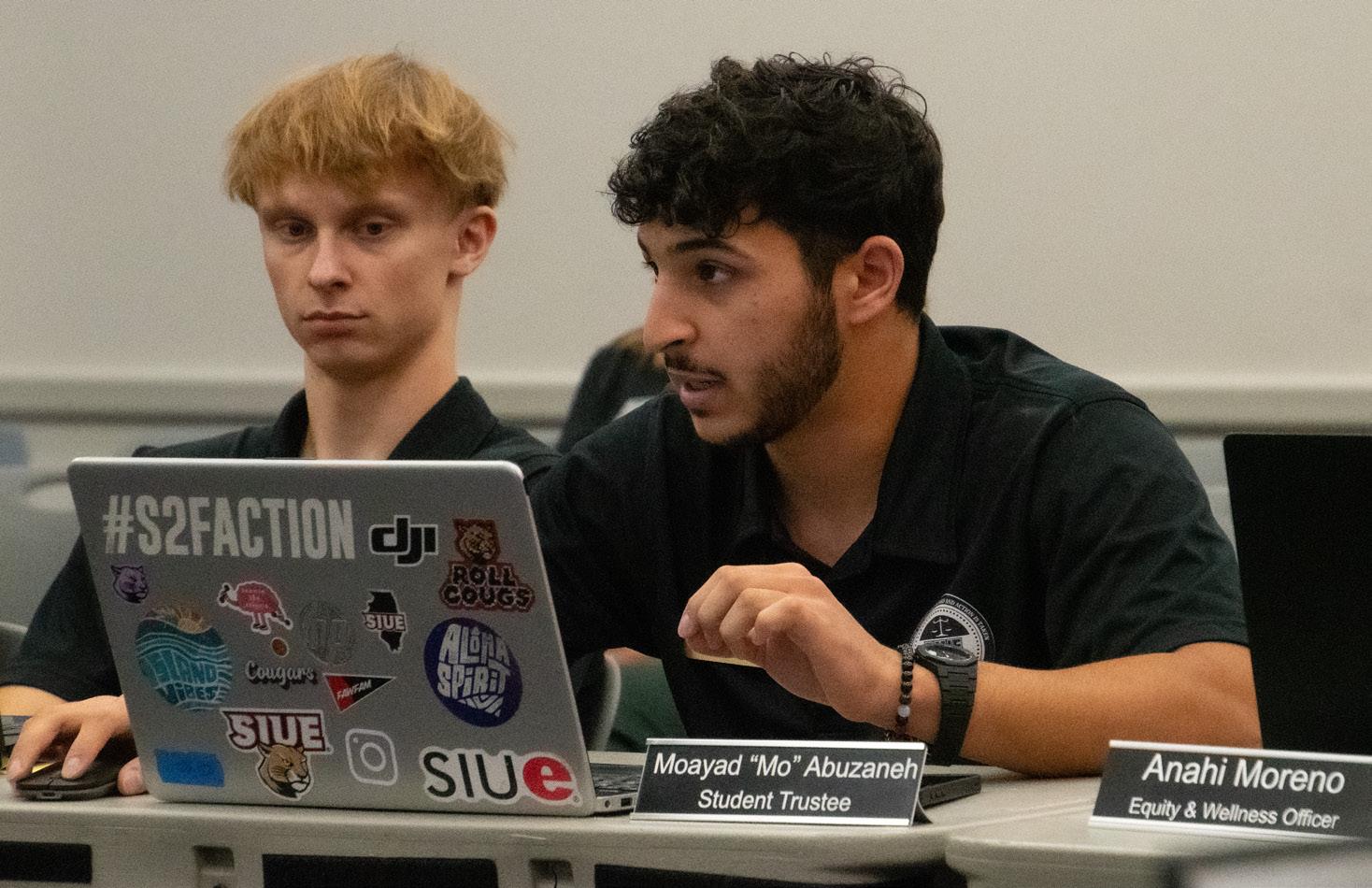
and approved as fee commissioner. He will serve on the Fee Commission in the spring, which makes recommendations to the Board of Trustees on certain budgetary topics.
Four travel requests were approved as well, though there was some controversy about how best to hear them.
After the first request was approved,
| Pedro Henrique G-M / The Alestle from the National Society of Black Engineers, Senator for the School of Engineering Shihab Alseikh asked if the Senate could hear the next three requests as a block, meaning they would all be voted on together.
“You can, but don’t,” Nestor said.
Adviser Liz Delaney then made a point of clarification, saying that Alseikh
could make the motion. It failed with 15 votes no and just four votes in favor.
The other three travel requests were for the American Marketing Association, Christian Pharmacists Fellowship International and Black Campus Ministries. All requests were for $600 each.
The Game Development Group’s program request for $1,375 for Cougar Jam was also approved. There is another, separate event called Cougar Jam that is not associated with this organization, but Delaney said there are no rules saying two events cannot have the same name.
Hive Dance Co. was the only petitioning student organization, a club “aiming to build an inclusive dance community using diverse styles of music such as K-pop, reggaeton and hip-hop,” according to Hays.
18 senators voted to approve the club. Freshman Senator Evan Cooper voted to abstain, and Alseikh voted against approving the club. Alseikh later said he voted against it because the Senate didn’t open the floor for discussion on the club before approving it.
Senator Gaby Allen was absent without an excuse for the fourth meeting in a row.
The next Student Senate meeting will be 6 p.m. Monday, Oct. 20, in the Goshen Lounge in the MUC.
SIUE’s ‘four-year-plan’ often turns into a five-year reality
PARIS THOMAS IV reporter
SIUE promotes its four-year graduation plan as a cornerstone of student success — a promise that a bachelor’s degree can be completed in eight semesters.
But for many students, that timeline stretches into a fifth year. The cause is not because of poor performance, but because of credit hour requirements. Rigid course sequencing and advising oversights can leave even diligent students short of graduation.
Assistant Director of the John Martinson Honors Program and Honors Adviser Ian Toberman said that advisers have to cater the student’s wants for their education, rather than trying to get them graduated in four years. Toberman has been advising honors students since 2019, but before then, had been advising since 2011.
“All of our approach as honors is based on where the student is,” Toberman said. “We have to figure out what the student needs.”
Under Illinois law, public universities must structure most bachelor’s degree programs to require no more than 120 credit hours, the benchmark for a fouryear degree. SIUE meets that standard on paper, but some students and advisers said the path to finishing on time can be far more complicated in practice.
“For students, I ask the question: do you want to do what you think is best for your education, or do you want to graduate in four years?” Toberman said. “I understand some students would like to be out of here in four years, but it may not be possible depending on their situation.”
For some students on campus, the lack of communication of information from advisers regarding that possibility is a prominent issue. In return, some students on campus said they believe that they should take matters into their own hands when it comes to curating their schedule.
Toberman said that when advising
students, he always makes sure they know that their path is more dependent on their personal situation.
“We all know it’s the ‘15 [credit hours] per semester to finish,’ but it’s again based on the student,” Toberman said. “For instance, if you fail a class or prolong another, you may not be able to finish in that window.”
Some students said they don’t receive this kind of information from their advisers, let alone the information on credit requirements.
Freshman geography major Ayden Macik said he didn’t get any information relayed to him about the credit hour requirement during his advising appointments.
“I felt like they should have mentioned it,” Macik said. “Information like that is too important not to discuss with students immediately.”
Wynton Stefanovicz, a freshman majoring in construction management, said that the process of getting ahold of advisors is difficult for him.
“There is obviously a lack of communication, at least for me,” Stefanovicz said. “If I email them, I won’t get a response back for nearly a week or two, which causes issues if I need some timely information.”
Caleb Spells, a senior public health major, agreed that the issue mainly comes down to poor communication between student and adviser.
“They tell you to stay full-time, but they don’t say that 12 hours a semester won’t get you to 120,” Spells said. “You need to take 15 every single time, or you fall behind. A lot of students don’t realize that until it’s too late.”
One adviser said that maintaining the four-year track can be difficult when programs evolve and course requirements change.
Thomas Willhoit, an academic adviser at the College of Arts and Science, said even one scheduling setback can delay a student’s graduation by a full year in certain majors.
“If a student drops a course that’s a prerequisite, and that class only runs once a year, it can throw off their whole plan,” Willhoit said. “We try to emphasize that from the beginning, but students don’t always realize how tightly these programs are structured.”
As a second-year adviser, Willhoit said there are difficulties that advisers like him can face with assisting students in their particular major.
“There’s just so many degrees,” Willhoit said. “I’m still learning, but at times, it can be tough since they have all these different processes.”
With large advising caseloads and a constantly evolving curriculum, Willhoit also said it’s difficult to ensure every student fully understands how their degree map aligns with total credit requirements.
“We’re constantly trying to improve how we communicate that information,” Willhoit said. “But ultimately, students need to be proactive about tracking their credits each semester.”
“What I do is just meet students where they’re at, and I try to help them as much as I can,” Willhoit said. “If everybody’s life was perfect, and if everybody learned the same, that sample curriculum would just hold true for everyone.”
Spells also said that students need to be more in control of their schedule and their path, especially if they want it a certain way. However, Spells’ reasoning is due to the errors he believes advisers can make and from what he knows from his peers’ experiences.
“I knew a couple seniors whose advisers had made a mistake, and that led to them taking one or two more extra semesters,” Spells said. “I would just suggest all students be heavily in tune with their path and have full control of it.”
“It’s not that SIUE is trying to mislead anyone,” Spells said. “It’s just that the system assumes you already know how it works — how many credits you need, what counts and what doesn’t. Most of us don’t figure that out until junior or senior year.”
The Illinois requirement of 120 credits is what Willhoit believes to be the main issue that affects the advising process. He also believes more funding would alleviate the situation.
”I believe if the universities were funded like how they used to be, people can move at their own pace comfortably,” Willhoit said. “Then it allows for students to further receive their education the way they want to.”
“It seems to me that they want to keep the same requirements from that era, even though the funding and societal expectations are quite different,” Willhoit said. “I don’t see the problem if a student can get out at 90 credits or whenever they finish their required classes for their major.”
Stefanovicz says he hopes that his generation of students can avoid those pitfalls.
“I think hearing from older students helps,” Macik said. “If I know that 15 credits per semester is the key, I’ll make sure I hit that, because I’d rather plan ahead now than pay for an extra year later.”
SIUE continues to highlight its fouryear graduation goal as part of its commitment to affordability and student success.
Willhoit said he remains hopeful about improvements in advising and degree tracking.
“Our goal is always to help students graduate efficiently, however, it’s a shared responsibility,” Willhoit said. “When students check their degree audits regularly and communicate with us, they have a much better chance of finishing on time.”
For Macik, the message from upperclassmen has already made an impact.
“I know it’s going to take planning,” Macik said. “I’m determined to graduate in four years — but I also know now that I have to watch my credits every step of the way.”
Minor retained as chancellor amid union call not to rehire
DYLAN HEMBROUGH
editor-in-chief
Chancellor James T. Minor was rehired by the Board of Trustees at its Sept. 18 meeting. However, not all at SIUE are happy about the decision.
Minor’s first contract, signed and approved in 2021, provided for his employment through Feb. 28, 2026. The new contract extends his employment through Sept. 30, 2029.
Minor’s new contract gives him a base salary of $378,000. This is an increase of $38,000, more than 11 percent, from his initial base salary of $340,000 in the 2021 contract.
He also receives a $50,000 housing stipend “for a residence within the region” around SIUE. His 2021 contract provided up to $35,000 for moving to the Edwardsville area.
The 2025 contract is overall very similar to the 2021 contract. Minor is still afforded retirement benefits, health insurance benefits, sick leave, paid vacation and a university-maintained vehicle.
SIU System President Dan Mahony and SIUC Chancellor Austin Lane can both receive “incentive compensation” bonuses of up to $115,000 for Mahony and up to $65,000 for Lane. These bonuses are awarded for “meeting annual goals which are mutually established in advance for each goal cycle” and must be approved by the Board of Trustees before they are given.
According to Mahony, the bonuses are provided by the SIU Foundation at Carbondale.
Mi nor does not currently receive an incentive bonus.
“The SIUC Foundation decided to provide the funding for a bonus for President Mahony and Chancellor Lane, like they provide to other SIUC Foundation staff,” Board of Trustees Chair J. Phil Gilbert wrote in an Oct. 6 email. “The SIUE Foundation has not made a similar decision which is why Chancellor Minor’s contract extension did not include a bonus provision.”
“The performance bonus for one chancellor and not the other is not a reflection of a difference in the evaluation of their performance,” Mahony wrote in a July 27 email.
The day before the Board of Trustees met to discuss and vote on Minor’s rehiring, the AFSCME Local 2887 union emailed the board a statement demanding they vote not to retain Minor.
“Chancellor James T. Minor has consistently ignored the expertise and input of SIUE employees,” the union wrote. “The results have been a series of misguided decisions that waste more money, squander time and damage morale.”
According to the union, examples of Minor’s poor leadership include the “rebranding debacle,” the “false budget crisis,” in reference to Minor’s actions to eliminate SIUE’s budget deficit and “fearmongering and misinformation,” in reference to the program cuts that administration began proposing last spring.
Via University Marketing and Communications, Minor did not comment on his rehir ing.

Increased student enrollment stretches department resources thin
amount of extra stuff,” Duff said. “We handled it, but those people that we hired for fall are going to be let go in the spring because there are no classes.”
Duff said that teaching assistants in his department are contractually obligated to teach two sections each, but the disparity between the number of sections from fall to spring means that there will not be enough work for those students in the spring semester.
To counterbalance this, Duff intends to reduce the course caps in the spring to spread out students among their lecturers.
“It’s been a real juggling act for us. I think we’ll be marginally okay, but I really don’t want this to happen again,” Duff said.
Duff said ACS 103 used to be capped at 30 students. About a year ago, they increased that cap to 32 to accommodate more students and adjust their budget. So, even before this fall, courses were already overcrowded.
“ACS 103 is very hands-on, very applied. You’re constantly doing things in class with other students. There’s presentations, there’s group work,” Duff said. “It’s sort of the nature of the class. A couple of our classrooms barely hold 32, and now they’re at 34, so you feel like you were put in there with a shoehorn.”
Duff said that introducing
more students to a single classroom reduces the amount of time that the class has to cover new material.
“Either everybody’s presentations have to get shorter, or you have to have less material to cover. Or, you have to rush through it more,” Duff said.
“You feel like you’re cutting corners here and there to try and make sure everything gets in. We’re adjusting, but it makes you make pedagogical decisions not so much based on what’s the best way, but on what’s the most time-efficient way. You hope that those two things aren’t going to contradict each other.”
Duff said that enrollment numbers rising is a great thing, especially for ACS, as general education courses can be a great recruitment tool for students who were previously unaware of what ACS was.
Duff said that his department has tried to absorb most of these last-minute adjustments, disadvantaging his own peers and staff, but he hopes that the students are still getting a good experience out of it.
English Composition 101 and 102: ‘A serious challenge’ Johnson said that around half of the English department is on an overload this semester — meaning that they are teaching more courses than their contract asks of them.
“[What’s] problematic is agreeing to do an overload and
finding out later that the enrollment cap was increased. That’s backwards,” Johnson said. “There are quite a few first-year writing teachers who are not happy about the order in which that was done.”
“The reason it’s a serious challenge is that first-year writing, perhaps in particular, is very student-centered. In fact, we read everything our students write and respond to everything our students write. So, there’s a lot of contact hours, a lot of individualized instruction, beyond what you might expect,” Johnson said.
Johnson said that each student in an ENG 101 course is expected to write somewhere between 6,000 and 7,500 words over the course of the semester. In ENG 102, this number is between 8,000 and 10,000.
“[This] gives you an idea of the amount of extra time that an individual teacher would have to put into a class given one student, let alone four or five students. Each increase of one can actually be pretty dramatic in terms of time. So, with rough numbers, if a teacher has five extra students, let’s call that 50,000 additional words of formal prose,” Johnson said. “To put that into perspective, your average novel is something like, what, 80,000 words?”
Johnson said that the concerns of the department align with the concerns of administration.
“I do get the sense that [Chancellor James T. Minor] is more interested in numbers than effective pedagogy,” Johnson said. “I want people to understand that the pedagogy itself is affected. And the argument that ‘it’s just one student’ doesn’t work. Studies have indicated that average increase in first-year writing classes decreases retention.”
The English department is working with the dean’s office to be sure that adjustments for the spring semester can be made in a timely fashion.
“You support the teachers, you’re supporting the students,” Johnson said.
Admissions Office: Hiring successes and ‘intentional’ enrollment efforts
“All of us on this campus, we have to be competitive with other colleges and universities, and we acknowledge that students have a choice when they’re going to school,” Ray said. “We want to do our best to demonstrate and show off those key aspects of what makes SIUE special. We have to do that by presenting ourselves in the best possible ways.”
Ray oversees the recruitment of domestic undergraduate students. She said that her office functions as an “initial touchpoint” for prospective students to ask questions and familiarize themselves with SIUE.
Her team visits high
schools and college fairs, addresses emails and calls and performs proactive outreach by contacting potential students. The office poured resources into Admitted Student Day, planning food, giveaways and “SIUE Bound” yard signs to entice student participation.
“Our increase in enrollment was very intentional. There has been a strategic plan in place even before I started that the goal is to increase our enrollment to 14,500 students. Across the university and especially the leadership level, that is our goal. So, we do need to respond and be prepared for increased enrollment as we hopefully continue to have year over year to get to that goal that’s been discussed,” Ray said.
“It really just depends on the year and what our priorities are, and that may be priorities that have been given to us from university leadership, such as the chancellor or, who I report to, the vice chancellor of enrollment management,” Ray said.
“I’m really proud and really grateful of the individuals on my team and even across campus that have been so willing to say a change needs to happen. We’re on board for that. Let’s move things forward. Let’s adjust,” Ray said.
This article is supplemented by an interview conducted by Dylan Hembrough.

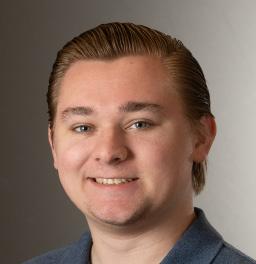





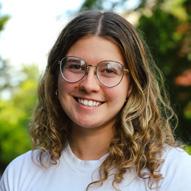


HAVE A COMMENT?
Let us know by scanning here: Campus Box 1167
Illinois 62026-1167
LETTERS TO THE EDITOR POLICY:
The editors, staff and publishers of The Alestle believe in the free exchange of ideas, concerns and opinions and will publish as many letters as possible.
Letters may be submitted to: The Alestle Morris University Center Room 0311
All hard copy letters should be typed and double-spaced. Letters should be no longer than 500 words. Include phone number, signature, class rank and major.
We reserve the right to edit the letter for grammar and content. Care will be taken to ensure that the letter’s message is not lost or altered.
Letters to the editor will not be printed anonymously except under extreme circumstances. We reserve the right to reject letters.
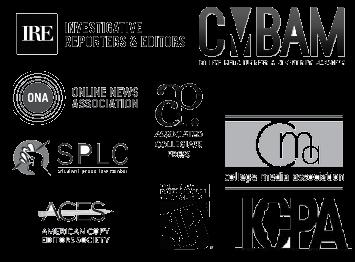

U.S. economy showing bachelor’s degree no longer enough, universities need to adapt
ALESTLE STAFF editorial board
Universities have served as the gateway to employment for decades of our nation’s history. However, with recent trends in the economy, students that earn a bachelor’s degree may not be guaranteed career success.
College graduates and soon-to-be graduates across the nation are facing growing concerns with fnding employment fresh out of university.
“The unemployment rate among recent graduates has been increasing this year to an average of 5.3 [percent],” according to an NBC News article.
The article said the job market appears stable for those currently employed but shaky for those trying to enter.
According to Axios, job postings have declined on job searching sites like Indeed.
“The number of job listings overall on indeed. com dropped 7 percent in
August from a year ago — the same as the number of job postings for entry-level workers,” according to the Axios article.
U.S. economic uncertainty has contributed, but a major factor lies with the decline in federal employees. The White House published a fact sheet emphasizing President Donald Trump’s executive order to shrink the federal workforce.
“There are too many federal employees,” according to the White House.
“The State Department is not hiring. In fact, it cut more than 1,300 jobs this past week as part of a broader government downsizing,” according to an NPR article.
The private sector has also seen a slow down in rapid employment growth due to the uncertainties with the U.S. economy. One area unaffected by the negative trend is skilled trades. According to Forbes, that industry has seen rapid growth.
“The skilled trades sector in the United States is experienc-
ing a renaissance. It’s fueled by massive infrastructure investments, a shift toward green energy and a critical shortage of qualifed workers,” Forbes said.
The federal government likely won’t cease its goal of workforce revamps under the Trump administration. What remains to be seen is how colleges respond. These institutions should be helping their students — who pay thousands of dollars — to prepare for this market.
This principle of colleges only supplying a degree is no longer suffcient. Colleges need to take steps to implement multifaceted skills for students to learn. Schools need to require better career preparations and also offer more skilled trade courses in tandem to a degree.
Career preparations could include multiple required internships before graduation or better community connections to fnd jobs for students once they graduate. Strengthening elements like career development might enhance students’
chances at making it into a tough market. It should be on individual departments to push their students to be ready for the feld they enter too. The mass communications program requires an internship to graduate. Many health care programs require weeks’ worth of rotations in the feld. It’s a good start, but these departments may need to require more to help students build their resume.
Colleges that provide skilled trade education in tandem to earning a degree may provide students with multiple options for jobs if one sector shows shaky hiring trends. They may also prove more qualifed than students who only have a degree. Oftentimes, community or two-year colleges offer trade classes. Larger institutions should adopt this principle and expand on it to provide students with more outlets of work.
Our economy is constantly changing, and it is up to the universities to change with it to better serve their students.
THE ALESTLE ON FILM THE ALESTLE ON FILM THE ALESTLE ON FILM
play menu
scene selection

metro east markets: movie theaters pg 6
reel experiences: siue students learn the art of flmmaking
pg 7
olivia’s corner: an interview with ‘napoleon dynamite’s’ efren ramírez
pg 8
MARKETS metro east east metro Movie Theaters
Movie theaters are a great place to catch a movie, and also eat some probably overpriced buttery popcorn. Let us help you fnd your go-to theater.
We reviewed local cinemas from Edwardsville to St. Louis. We rank based on ambiance, service, price and selection.
Marcus Theatre leaves a mark: in memory and in wallet
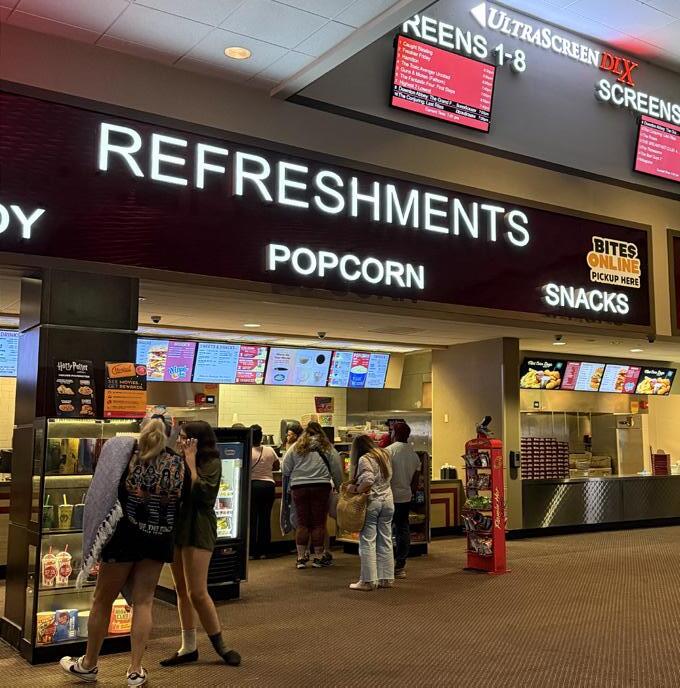

DESTINY ALBRECHT copy editor
The Marcus O’Fallon Cinema offers an assortment of movies, a wide selection of fresh but pricey food and a nostalgic ‘90s theme that transports you back in time.
The theater’s exterior featured retro-style fonts framed in bright LED lights, with movie posters lining the wall, giving the building a classic vibe. Inside, the space was open, providing plenty of room for crowds.
As for the food, I was surprised by how much variety there was — not just standard snacks but full meals, too. The menu included concessions like popcorn, pretzels and hot dogs as well as atypical entrees for
a theater such as wraps, cheeseburgers and chicken tenders.
While the service was excellent, the prices were considerably high. In terms of the movie tickets themselves, I could justify the cost as it was only $13 for the reclining seats. The food, though, seemed absurd — $15 for a burger and fries at a movie theater is ridiculous, especially considering a drink was not included.
Overall, the theater delivered a warm, fun atmosphere with great service. While the ticket prices felt fair for the comfortable seats, the food costs were definitely a downside. If you’re planning to visit, enjoy the moviegoing experience — but maybe eat beforehand.
Wildey Theatre creates classic movie atmosphere for affordable price
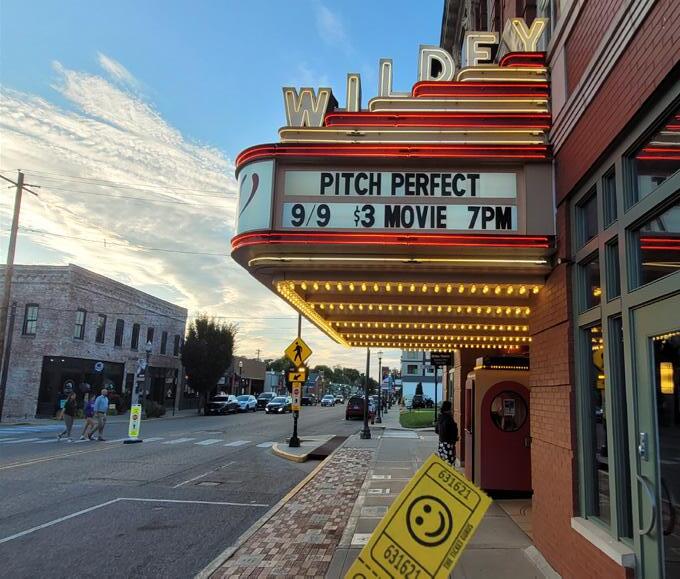
SOPHIE HAWKINS online editor
Friendly staff, cheap prices and neon lights capture the essence of the Wildey Theatre in Downtown Edwardsville, the perfect place for your next movie night.
I went with several friends to go see “Pitch Perfect” on the Wildey’s $3 Movie Tuesday. On select Tuesdays, the theater shows a movie with $3 admission to all patrons and only $1 to SIUE students, a price nearly unmatchable for modern-day entertainment.
When we went inside, we were greeted
by theater workers who chatted with us about the movie and jokingly made sure we were prepared to sing since we chose to sit at the front of the theater.
We didn’t end up singing but had a great time nonetheless, with plenty of money to spare to get ice cream after the show. We were greeted by the workers on the way out as well and left to see the Wildey marquee lit up against the night sky.
This was not my first time going to the Wildey and will certainly not be my last. The welcoming atmosphere, affordable price and classic aesthetic make the Wildey a perfect going-out activity.
Arkadin Cinema and Bar a microtheater that packs a punch
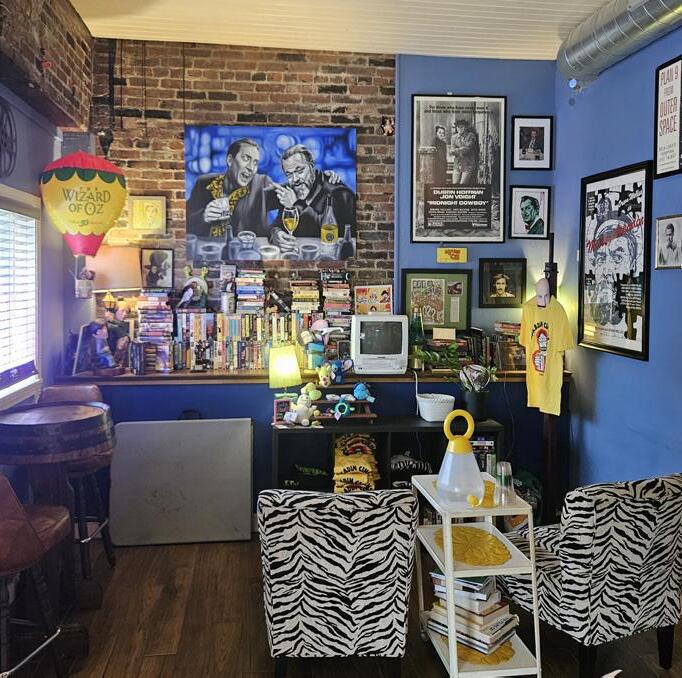
GAVIN QUINLAN reporter
Don’t let Arkadin’s small size and unassuming exterior fool you. This theater in the heart of St. Louis’ Bevo neighborhood is full of personality and charm.
The lobby is colorful, welcoming and doubles as a bar, so customers can order concessions to enjoy before, during and after the movie. I ordered their Spiced Palmer — a mocktail made with ginger beer and Sicilian lemonade. $7 seemed steep for my drink, but the ticket was well worth the flat $9.
The cozy theater provides plenty of different seating options. I sat in an armchair with a small table at my side, a comfort paralleled by no other theater I’ve experienced.
Indie film trailers and custom-made messages played in place of typical previews. A clip from an interview with the movie’s director even played before it started.
Arkadin offers a different movie every day, ranging from obscure silent films to modern indie movies. I watched “Celia,” a gut-wrenching ‘80s film about growing up during the Red Scare in Australia.
Though they screen a very limited number of films each day and the schedule can be hard to work around to see a particular film, it’s a great way to expand your horizons and watch something new.
I’ll be sure to return to Arkadin sometime, maybe on one of their mystery movie nights.
Skyview Drive-In delivers nostalgic experience at decent prices
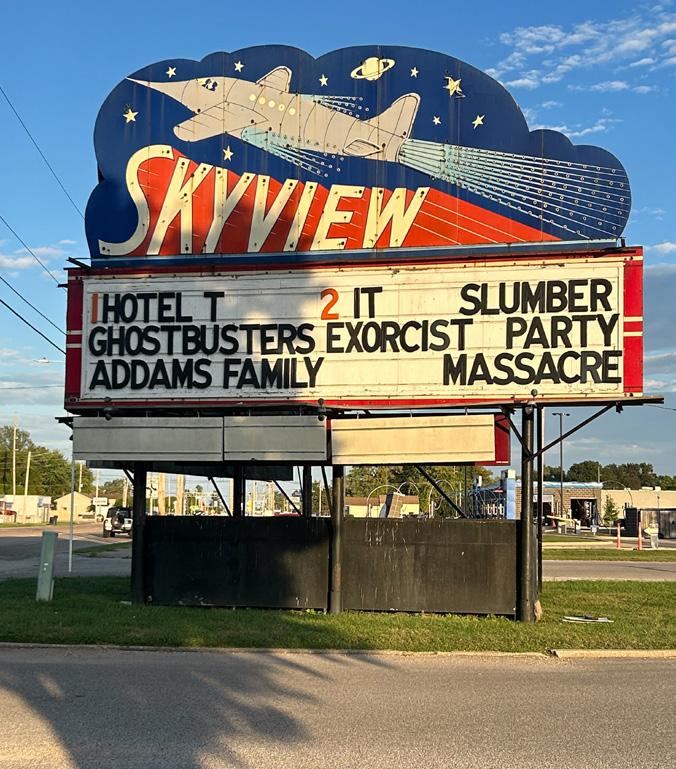
Ranked best drive-in theater in the nation, Belleville’s Skyview Drive-In offers a nostalgic theater experience with quick and easy service.
During the month of October, Skyview features classic Halloween movies which change every weekend. When I went, “Coraline” and “Monster House” were playing on screen one. Tickets were $12 per person and covered both movies on one screen. It’s cash only, which was a little inconvenient for me, but still a decent price.
The ticket booth staff were kind and handed us a paper with clear instructions and a trash bag.
Screen one often features family-friendly
titles and is known for its large playground in front, where kids can play before the movie.
Skyview’s concession stand is open throughout the movie, but I did not purchase anything from it because they do allow outside food and drinks.
Overall, I had a good experience and everything went smoothly. While we had a good view and radio connection from inside the car, I recommend bringing lawn chairs and a radio to prevent possible battery drainage for vehicles that may not be as equipped..
Another thing to note is that because it is an accessible, family-friendly and outdoor theater, there will be the occasional baby cry, car horn and light flash. If you are looking for complete silence while watching, this may not be the place for you.
For more Metro East Markets, visit alestlelive.com or scan this QR code:
Lights, camera, collaboration: SIUE students build bonds through flm
DESTINY ALBRECHT copy editor
For many SIUE students, the path to filmmaking begins with Advanced Video Production, a course that challenges students to write, film and edit short video segments that later air on a student-produced news and entertainment show called “SIUE Global Village.”
But what starts as an assignment often leads to friendship, collaboration and awards for students who develop a love for production.
The class brings students across departments to work together on projects, laying the groundwork for bigger ventures like “The Lesser Key,” the Department of Mass Communications’ first 32-minute student-produced film.
Building foundations in film
Inside the Department of Mass Communications, Advanced Video Production serves as one of the program’s most hands-on creative experiences.
According to Tier II Instructor Cory Byers, the class is designed to help students transform ideas into finished projects while building skills that prepare them for larger aspirations.
“I really like working with student filmmakers,” Byers said. “I think that’s one of the reasons why I like teaching — because I’m teaching things I’m really passionate about.”
Byers said the collaborative setting allows students to learn from one another while developing both technical and creative abilities.
“As we go through the semester, you can see the light bulbs in their head starting to click on and realize this is what [they] have to do to make the project as good as it could be,” Byers said.
Working on “Global Village” segments provides an environment full of encouragement and creativity for students, like junior mass communications major Ella Lawrence.
“To be in a room full of other people who have the same passions as me, and they’re so hyped to be there, it’s really nice,” Lawrence said. “[Working on ‘Global Village’] made me realize how much I love production, and my skills have sharpened. I’d say almost every skill that you need is
going to be [fine] tuned in there, even if production is not your main squeeze.”
In order for those to familiarize their skills more outside of in-class exercises, the Department of Mass Communications offers rental material to take home.
The opportunity to borrow cameras, light kits, audio recorders, microphones and other equipment not only supports coursework but also bridges the gap between class and external practice. This kind of experimental learning can be transformative, particularly for those without access to such costly tools.
“I think [the class] teaches a lot of media kids what it’s really like to [to shoot and edit films]. It’s a great resource for people who don’t have funds to buy the equipment themselves,” Lawrence said.
From visions to on-screen
The teamwork and skill-building developed in Advanced Video Production often inspire students to pursue larger creative projects out of class.
Over the years, those efforts have led to several independent short films such as “No Second Chances” by mass communications graduate Tom Drake, “A Twisted Tradition” by senior mass communications major Aidan Keen and “A Hidden Agenda” by mass communications graduate Annabelle Brown — winning placement and an honorable mention in the Wildey Short Film Competition last spring.
While production skills learned from their education came into play, what strengthened their films was the inclusion of training actors, according to Byers. Theater students who participate in mass communications projects gain on-camera experience, while filmmakers learn to direct performers.
“I’ve encouraged my students to work with theater actors anytime I can, just because it really raises the level of their projects so much,” Byers said. “Having somebody who’s actually trained in acting really gets you a lot more freedom as a director.”
Ryan Whaley, a senior theater and dance performance major, said those experiences don’t just reinforce professional works, but they also build lasting friendships.
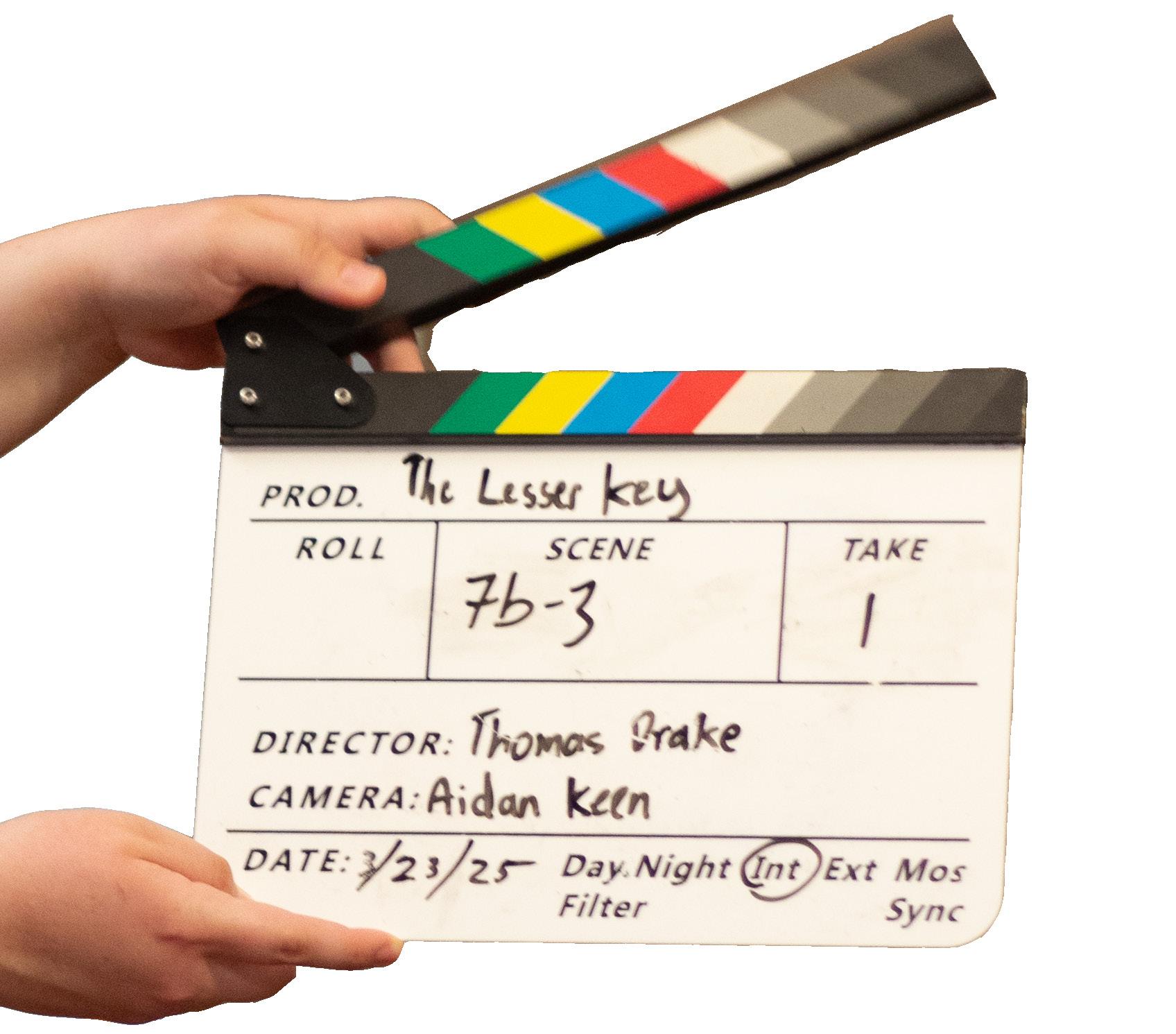
“The opportunity to get to work with people regardless of the quality, [or] their vision, it’s an opportunity, and it all helps,” Whaley said. “It’s really just a
“I think we care enough about [and] we’re passionate enough about making [films] that we’ll find a time,” Dalan said.
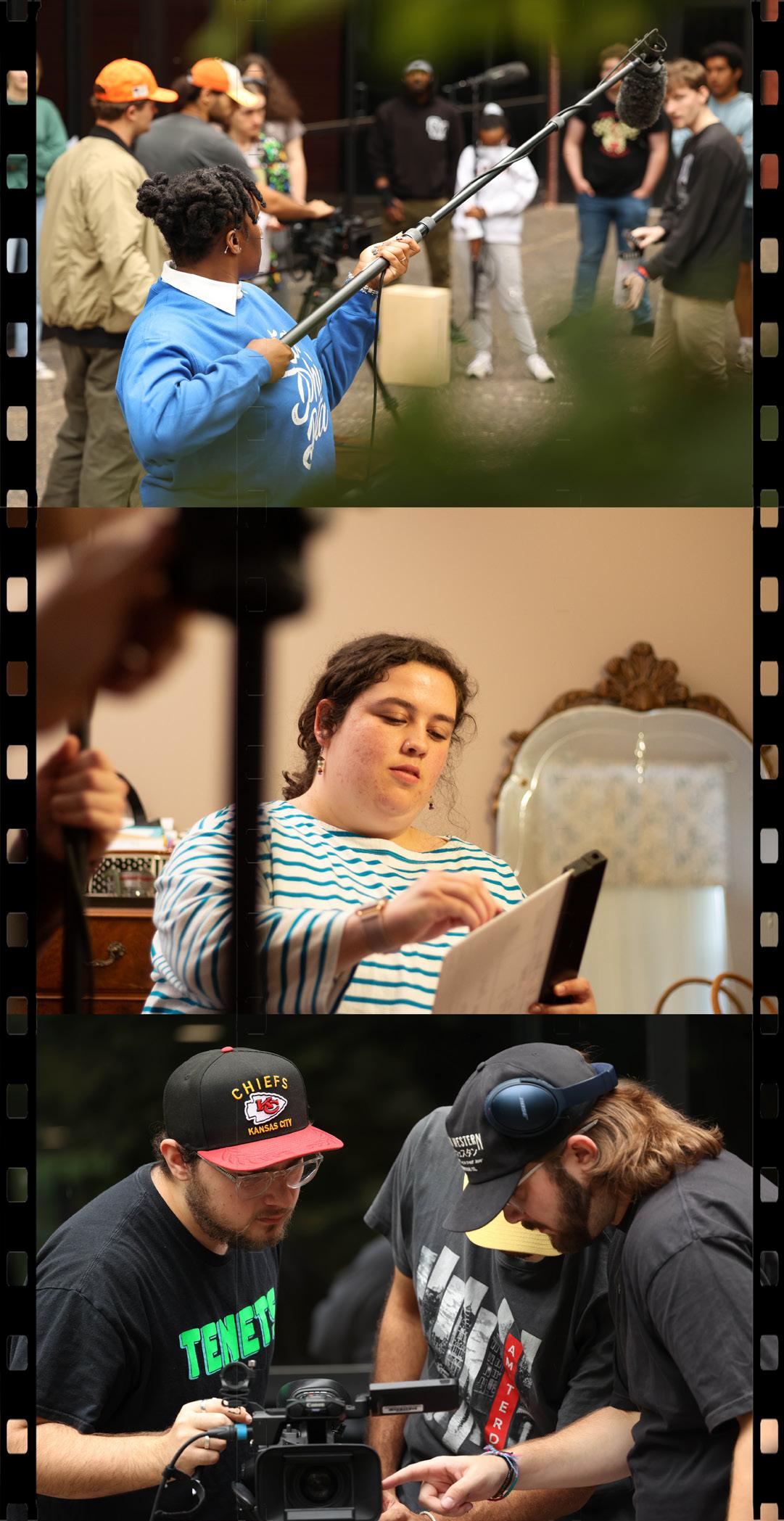
gift. Having those connections to mass communications is going to be boundlessly helpful in the future, too, because those people are going to end up doing work in every avenue.”
As new filmmakers prepare to take their place in classes like Advanced Video Production, Byers said the connections students make and the skills they develop can shape their careers long after graduation.
“Networking is super important, because you want the right people to see your work, and they can help your career on the way,” Byers said.
Mass communications graduate Andrew Dalan believes that passion naturally carves out its own time and is one shared by many students who pour their energy into film. For them, the long hours on set, the latenight editing sessions and the constant collaboration are less about obligation and more about fulfillment.
students, friends and family to complete strangers.
According to Drake, seeing the final product premiere was a surreal moment.
“It was awesome and really enjoyable,” Drake said. “It was very weird to have strangers come to you and tell you how good it was.”
The film showed students what collaborating in the media field can do for one’s career.
Senior mass communications major Aidan Keen was a co-producer, director of photography and head editor on the set of “The Lesser Key.”
“I met a lot of really great students and filmmakers in [Advanced Video Production], and we all had similar interests, and everyone in the class became very collaborative by the end of it where we’re all working together, helping each other out in certain projects,” Keen said.
For Keen, watching their work on the big screen was a highlight of the experience. The opportunity to show the film to people “on the biggest screen possible” was a great opportunity.
He also said the project deepened his confidence as a filmmaker, furthering his skills and providing confirmation that production is the right direction for him.
The team’s dedication to the project reflected their shared passion for filmmaking.
“We [were] able to really show how much we all cared about the medium and this project,” Keen said.
Drake said he hopes the film will encourage other students to pursue creative projects of their own.
Whaley felt that passion led to the projects rarely feeling like work.
“Oftentimes, when I would come into a shoot, it didn’t feel like work,” Whaley said. “And it was easy in the way that I didn’t need to have it be something I worried about when I wasn’t there.”
‘The Lesser Key:’ A student milestone
One of the most ambitious outcomes of this creative network is “The Lesser Key,” a 32-minute independent film written and directed by mass communications graduate Tom Drake. Created as his final project for senior portfolio, it stands as the longest student-produced film in SIUE history.
With months of research, Drake said he put his heart into occult storytelling to portray a friendship facing paranormal challenges, leaving one of the characters “to try and save his friend before it’s too late.”
It aired on the Dunham Hall Theater screen on Sept. 20, with a good crowd from
“I just hope it inspires students to make more films, watch more films … and people different than me — different ethnicities and genders than me — to make more films and appreciate more films,” Drake said.
Dalan, who was a co-producer and worked on editing and sound, said the film’s creative process relied heavily on trust among team members in order to put Drake’s vision together.
Composing the score was one of the most engaging parts of production, according to Dalan.
“I just kind of make music off of vibes, and it’s kind of apparent when you watch the movie, [because] there’s this ambient drowning and a lot of synths with drums here and there,” Dalan said. “It was really fun.”
Drake plans to use this film as a turning point in his life, looking forward to creating new stories, developing his skills as a director and continuing with his friendships he made at SIUE.
“For my own career, I want to learn from [the film] and keep gaining momentum, whether it be writing for books or making movies,” Drake said. “I want to keep that creative momentum going and keep the connections I made from this film to make more movies in the future.”

Efren Ramírez
still has my vote: 20 years after Pedro in ‘Napoleon Dynamite’


OLIVIA
WHITLOCK
copy editor
When you watch as many films as I do, you’ll inevitably be asked: “What’s your favorite movie?” Without skipping a beat, my answer is always “Napoleon Dynamite” (2004). I’ve been watching it my whole life, with memories I can trace directly back to this film. So, when the opportunity arose to interview Efren Ramírez, to say I was excited would be a complete understatement.
For those living under a rock, “Napoleon Dynamite,” directed by Jared Hess, follows an eccentric teen, Napoleon Dynamite (Jon Heder), navigating the challenges of high school. The cult classic was produced on a modest $400,000 budget and went on to earn $46 million at the box office. Ramírez portrays Napoleon’s new soft-spoken friend, Pedro Sánchez, who re mains a cultural phenomenon — even among those who haven’t seen the film — thanks to the repeated tagline, “Vote for Pedro.”
Getting the chance to ask questions I’d always wondered about as a fan — and as a movie buff, gaining firsthand insight into the industry — was a dream come true.
said. “Pedro’s naivety, he was so naïve to the world, but Giel, his cousin, had some sweet skills [and] an understanding to life itself and I thought, ‘Well, maybe if I put [them] together and trust what I wanted to create … maybe that’s Pedro.’”
Ramírez said that even on his first day on set, he knew this movie was going to be unlike anything he had previously starred in.
“When I met Jon Heder as Napoleon, he had the big glasses and the Moon Boots, and I [saw] Uncle Rico (Jon Gries) and I [saw] Kip (Aaron Ruell). [I was] like, this movie’s gonna be really different,” Ramírez said.

With a movie as huge as this one, forever ingrained in pop culture, I had to wonder — with fans always wanting the same lines repeated and interviewers asking the same ques

who in a sense of doubt and fear, he ends up getting a best friend, and in that friendship, they help each other’s dreams come true.”
“The most important thing about acting is that it’s nev er about you … You take living those lives with such great honor and with such great protective force that you trust in your imagination, into the ‘I don’t know’ and ‘let’s see what happens.’”
characters’ intended direction.
“I would tell all the fans that the door is not closed [regarding a Napoleon Dynamite sequel] and if you put it out there in the universe, the universe will respond,” Ramírez said.

Ramírez said that as an actor, it’s his responsibility to fully embody his characters. He said he focuses less on recognition of his roles and more on honoring what the writers create, bringing each character to life in service of the story’s lesson and purpose within the script.
“Napoleon Dyna mite” was based on a short film Hess made at Brigham Young Universi ty in 2002, starring Hed er, titled “Peluca.” The character Ramírez would eventually play was originally split into two — Pedro and Giel.
“When I booked the job, [Hess] pulled me to the side, and he played his short film for me and told me to put these two characters [together] and make them into one,” Ramírez
“ In the characters I play, I try to fnd something that’s profound in their adventure, in the trek of purpose, of dreams... I try to leave a stamp of their ambition in the framework of the story that is created by the writers.” Efren Ramírez

one] where you play a character that’s loved and liked by everyone you know,” Ramírez said. “You play a character who leads with hope. You play a character
each and every one of these characters, but that only happens when they start to care for each other and help each other out. Life is hard, but you know it gets a little better when you get a little help from your friends.”

“In the characters I play, I try to find something that’s profound in their adventure, in the trek of purpose, of dreams, and I hope that they find something,” Ramírez said. “[I take] every opportunity to be able to look at a project and say, ‘How can I bring this character to life?’
I try to leave a stamp of their ambition in the framework of the story that is created by
Back in May, reports spread about a potential “Napoleon Dynamite 2” being in the works.
As someone who is quite anti-sequel and anti-remake, I don’t know how the original charm and heart could ever be recreated in a high-budget sequel.
In fact, “Napoleon Dynamite” and high-budget don’t even belong in the same sentence.
Ramírez said that for any sequel to succeed, it must remain true to the original characters’ journeys while paying homage to the creators and following the
To this day, the simplicity and wholesomeness of this creative oddity is adored by all ages, as many can find a character to connect with, and every character — no matter how peculiar — everyone wins in the end.
“There’s no special effects, there’s no green screens, no real big stunts. All we have is each other,” Ramírez said.
“Something great happens to
ALESTLE CLASSIFIEDS GIVE
Place your classifed ad at a convenient time for you using our easy and secure online portal: alestlelive.com/classifeds
DEADLINES:
By noon Monday for Thursday issue or any time Online
HAVING TROUBLE? Call (618) 650-3528
ALESTLE OFFICE MUC 0311

Jon Heder, Efren Ramírez and Jon Gries are currently touring “Napoleon Dynamite Live,” an interactive experience celebrating the over 20 years since the film’s release with fans. Due to production scheduling, coverage of the Oct. 9 event in St. Louis unfortunately cannot be included in this piece.
Are you in search of the perfect storage units in Edwardsville? We are located less than 3 miles from the SIUE campus. All-digital access and no lock required. Locally owned and operated.

DYLAN HEMBROUGH editor-in-chief
The Alestle’s editor-in-chief, Dylan Hembrough,ispassionateaboutthenationalandinternationalpoliticalscene.Hewill sharehisopinionsoncurrenteventsinthis columnineveryissue.
On Sept. 22, President Donald Trump’s administration began making the claim that Tylenol use in pregnancy causes autism and that women should just “tough out” the pain. This new debate is part of a long history of blaming mothers and policing women’s bodies.
Tylenol, also called acetaminophen, is one of the only drugs considered safe to take during pregnancy, according to the American College of Obstetricians and Gynecologists. It’s a go-to medicine to alleviate pain and reduce fevers.
According to the Society for Maternal-Fetal Medicine, untreated pain and fevers can cause immense harm to unborn babies, anywhere from birth defects to miscarriage.
As President of the Autism Science Foundation Alison Slinger said, the claim came from out of the blue and is supported by zero evidence.
“No new data or scientifc studies were presented or shared. No new studies have been published in the literature. No new presentations on this topic were made at scientifc or medical conferences,” Slinger said. “Instead, President Trump talked about what he thinks and feels without offering scientifc evidence.”
What the White House says is “fact”
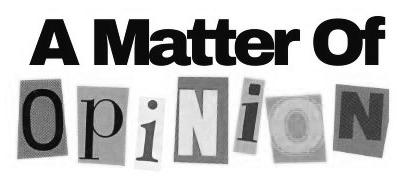
DYLAN HEMBROUGH editor-in-chief
“A Matter of Opinion” is an opinion column that features a personal, anecdotal account of an experience relevant to college students. Each edition, a staff member will write about something important to them in order to share advice, start conversations and invite our readers to connect with one another.
On May 21, 2018, my best friend died. His name was Adam Clack, and we were 14 years old. We were set to graduate from eighth grade four days later.
Death is a fact of life, but it still leaves a gaping hole in the heart when it happens. Childhood death in particular can feel sudden, unfair and meaningless, but there are a few things you can do to ease the pain and remember the dead, both by yourself and with others.
After Adam died, life felt empty. He and I spent much of our time together every day — we rode the bus together, we had many of the same classes and we were in many of the same extracurriculars.
The day after his death, one of our other friends brought up the idea of having someone read Adam’s graduation speech for him. His speech was about the potential he saw in his classmates, and he had wanted his speech to be chosen to read at
is a distortion of a more complicated truth. Numerous studies have “associated” Tylenol with autism, but correlation does not equal causation. In other words, to be scientifcally sound, you need to prove that there isn’t another factor at play. That hasn’t been done.
“He said, ‘Tough it out,’ meaning don’t take Tylenol or give it to your child. It took me straight back to when moms were blamed for autism,” Slinger said. “If you can’t take the pain or deal with a fever, then it’s your fault if your child has autism. That was shocking. Simply shocking.”
Over the decades, there have been many attempts to blame women for any perceived problems with their children. In the 1940s, according to NPR, the “refrigerator mom” theory became popular after child psychiatrist Leo Kanner blamed autism on highly-educated women. His reasoning was that if women were educated and working, they were “emotionally cold” to their children.
“A cold mother, at the time, pretty much meant an intellectual mother,” Marga Vicedo, a historian at the University of Toronto, Canada, said. “At the end of the day, saying it’s a mother’s fault is a very strong and powerful way of keeping mothers as the main caretakers.”
The “refrigerator mom” theory came about as women were entering the workforce during World War II, upending the rigid gender roles that had been in place beforehand, according to the National World War II Museum in New Orleans.
Tensions over women in the workplace continued long after the war, and
‘You
Tylenol tussle threatens bodily autonomy

Health and Human Services Secretary Robert F. Kennedy discusses possible link between Tylenol use during pregnancy and autism at press conference with U.S. President Donald Trump and Acting Assistant Secretary for Health and Head of the United States Public Health Service Commissioned Corps Dorothy Fink, right.
artifacts like the wage gap are still relevant today. Keeping women at home and reliant on their spouses’ paychecks limits their autonomy and freedom to shape their own lives.
Discouraging the use of an essential medicine like Tylenol also keeps women in the home and reliant on their spouses, as the pain of pregnancy can often be highly
| Andrew Harnik / Getty Images / TNS
disruptive to everyday life. As key players in the federal government turn their focus to women’s bodies more and more, their rights become less and less. From targeting diversity initiatives — which have overwhelmingly benefted white women — to overturning Roe v. Wade, those in power are hell-bent on controlling women’s lives.
aren’t alone:’ Coping with childhood loss and grief
graduation. When no else volunteered, I raised my hand. My “friends” didn’t like this too much, and over the next three days, they had their parents call the principal in an effort to overturn that decision. The principal read the speech instead, and I couldn’t do anything about it.
Our friend group did not survive Adam’s death. I wore my emotions on my sleeve, and being vulnerable in a small town often invites intense bullying. That’s what happened to me, so I lost the rest of my closest friends pretty quickly afterward — all but one.
This awful experience taught me a lot about life, friendship and emotional intelligence. What I learned helped not just me, but many others in my community.
First: fnd your people, and hold on to them.
Friends and family are crucial in navigating the stages of grief. Family members in particular have probably dealt with death before and can serve as an anchor for you. Your friends, meanwhile, are going through the same dark spot you are.
I grew closer than ever to the singular friend I had left, named Chase, and we came to trust each other with everything. He was there no matter what, he never let me down and, most importantly, he let me grieve.
My parents were instrumental in helping me cope at home. When my
great-grandmother died fve years earlier, my dad cautioned me against bottling up my emotions. Doing so doesn’t allow you to grieve, which can lead to even more trauma down the road. I took that advice to heart, and my parents were always there to hold my hand as I navigated my new world.
Second: fnd some meaning in the experience, and, if you can’t, make some meaning.
The seat next to me on the bus, in band and in scholastic bowl was suddenly vacant, and the mere thought of that empty seat often brought me to tears. Adam never got to earn his driver’s license or experience homecoming, so I kept the thought of him with me during those teenage milestones.
Adam and I were both passionate about scholastic bowl, so I devoted myself to the craft even more. Adam’s older brother, Nathan, was one of the best in the state, and he took me under his wing as I took studying more seriously. That led to another amazing friendship and some unforgettable memories.
I also set my sights on keeping Adam’s legacy alive, working with our village government to plant a tree and set up a bench in Adam’s name. I organized a ceremony one year after his death to dedicate the tree and bench, with Chase taking charge
of the horn quartet that played between speeches. I felt like I fnally got to do justice to my best friend in the way I felt was best, and I got to plan it with someone else who held Adam dear.
Starting in my sophomore year, I got the idea to write a book about Adam. After two years, I published “May 21: The Story of Adam Clack,” the proceeds of which help fund a memorial scholarship in Adam’s name.
Third: be at peace with that wound never truly healing.
This may sound defeatist, but I prefer to see it as realistic. Death punches a hole that can never be flled, and chasing that idea will leave you breathless and disappointed. There will always be a gap that special person once occupied, and coming to terms with that is a huge step on the path to healing.
It’s also important to allow yourself to grieve and ensure you do so in a healthy manner. Whether you need space from your daily life or want to dive into work, everyone copes differently. Cope healthily by keeping your own needs in mind and looking out for any destructive habits that may develop.
Death is awful, but my hope is that by sharing this story, I can help those who feel lost in their new reality. You aren’t alone.

which siu reigns supreme? ‘E’ vs ‘C’
Point: SIUE bigger, safer, better performer than Carbondale campus
TORRE JOURNEY reporter
According to national reporting, SIU Carbondale falls slightly short compared to SIUE’s enrollment, graduation rates and costs. In local safety and entertainment, there is no doubt that SIUE comes out on top.
Both universities in the SIU System have plenty of redeeming factors, but SIUE performs higher in graduation rates and frst-year retention.
According to the U.S. Department of Education’s College Scorecard, a collection of college performance data reported from four-year institutions since 1996, SIUE ranks higher than SIUC in graduation rates by two percent and meets the national average of graduation rates of 58 percent.
A strong retention rate can be a
measure for how well a school meets a student’s needs.
The scorecard shows that SIUE has a frst-year student retention rate of 71 percent compared to SIUC’s 69 percent.
All students share one crucial aspect in common while at college — dealing with the cost of tuition. In navigating expenses, we also wonder if our education will result in higher earnings.
The College Scorecard also shows SIUE’s average tuition cost of $13,696 is lower than SIUC’s by $2,481. Lower tuition costs create less debt for students receiving Financial Aid packages.
Both universities use the Carnegie Classifcation of Institutions of Higher Education, which uses information from the U.S. Department of Education’s scorecard and measures a student’s access to the school along with their earnings eight years after graduation.
SIUC is classifed as an opportunity
school with higher access and higher earnings. SIUE has higher access and medium earnings after graduation, but SIUE also offers some key programs SIUC doesn’t. Pharmacy and dental medicine are both offered at SIUE, and with the university’s proximity to St. Louis, jobs in the city are much easier to fnd.
Students also value safety from their schools and communities. The locations of both schools are vastly different. The FBI’s 2019 Uniform Crime Report on Illinois, a statewide registry of all crime data, shows Edwardsville is a far safer region to be a student than Carbondale.
With both cities having a population just over 25,000 in 2019, the crime report shows Carbondale had 208 violent crimes — 192 crimes more than Edwardsville. In terms of theft, Carbondale had 113 burglaries and 779 cases of larceny, or theft without force. This outnumbers Edwardsville theft by 98 burglaries and 610 larceny

cases. The crime report also states Carbondale had 932 property crimes — 739 more than Edwardsville.
Adventure and life experience are also factors for students.
SIUE is more than 1,500 acres larger than SIUC and has several exciting amenities on campus, including The Gardens at SIUE, the Center for Spirituality and Sustainability and the SIUE Nature Preserve. Additionally, SIUE is just fve minutes from Historic Edwardsville and 23 minutes from Busch Stadium and the Gateway Arch in St. Louis.
A new area of comparison is athletics. The Cougars, SIUE’s offcial Men’s Basketball team, won entry to March Madness in 2025, the NCAA Division I basketball tournament. While SIUC has made it to March Madness 10 times, they have not been since 2007.
Given the safety, entertainment and level of savings, SIUE is more than a vibrant campus. It is better than SIUC in many ways and is growing every day.
Counterpoint: SIUC harder, better, faster, stronger than Edwardsville campus
JACKSON BRANDHORST news editor at The Daily Egyptian
You don’t have to put the “C” at the end of SIU to clarify that you’re referring to Carbondale — everyone knows which school you’re talking about:
The Salukis. The OGs. The Big Dawgs. For starters, without context, the claim that SIUE is “safer” than SIU is a bit disingenuous. While it’s true that the cities themselves are comparable in size and that there is a discrepancy between the rates at which crimes are committed, Edwardsville is a stone’s throw away from one of the highest crime-rate places on the planet — St. Louis.
There’s not much else to do in Edwardsville except to go to St. Louis, where crime is committed at a rate nearly 10 times higher than the national average, according to FBI and World Population Review data. That would mean
tions in the United States — literally the highest possible.
SIUE is not an R1 university; it falls under “Research Colleges and Universities,” which denotes a much lower level of research intensity. This distinction matters, as R1 schools represent roughly the top 3 percent of all universities nationwide in both research expenditures and doctoral degree production.
According to the National Science Foundation’s Higher Education Research and Development Survey, which is used by Carnegie, SIU reported more than $58 million in annual research spending and awarded more than 100 research doctorates in 2023.
That’s right — more than 100 research doctorates.
SIUE’s research spending, by comparison, is typically around $30 million to $35 million, with fewer than 10 research doctorates granted in the same period.
That gap places SIU in a different ac-
izing political climate.
Our art, music and food scene refects a culture and environment that is both biologically and demographically fourishing. We have the longest-running punk house in the country in Lost Cross, a tradition of summer Sunset Concerts and a history of legendary performances from the likes of Johnny Cash to Elton John to the Red Hot Chili Peppers.
We are home to some of the most sought-after natural landmarks in Giant City State Park and the Shawnee National Forest — and that’s not to mention our nationally recognized campus arboretum, in which we eloquently weave the whimsy of southern Illinois fora into the foundations of our campus buildings.
Furthermore, the king of DIY and one of the greatest minds of all time, Buckminster Fuller himself, claimed Carbondale to be the center of the universe, and I can’t say I blame him for that self-centered remark. If he were alive today, he’d have been blown away by the fact that not just once, but twice, Carbondale found itself positioned on the path of totality amid a total

fcation is higher access, higher earnings.
On top of that, the Dawgs are classifed by the Carnegie Foundation as a “Doctoral University — Very High Research Activity (R1),” the highest possible designation for research institu-
the forefront of civil rights movements and social justice advocacy for decades. We’ve always been recognized as a safe space and a staple in the Midwest for both diversity and inclusivity — an incredibly important feat amid an increasingly polar-
It seems Mother Nature agrees with
Speaking of notable SIU affliates, have you ever heard of Hannibal Buress, Melissa McCarthy, Jenny McCarthy, Bob Odenkirk, Jim Belushi, Walt Frazier, Jeremy Chinn or
I couldn’t fnd much on notable SIUE alumni, but it’s cool that Gary Schroen went to Edwardsville. It seems that his contribution to the global War on Terror really paid off, considering that there are no more wars going on and that terror attacks no longer
I fear athletics is an incredibly poor topic for anyone from SIUE to be speaking on. The Dawgs have been to the Sweet Sixteen a total of three times, one of which was led by my all-time favorite Saluki, Brad Korn, who actually went to the NCAA Tournament three years in a row — something that
Also, just so the record is clear, SIU has played SIUE only 11 times in basketball, and we’ve won 10 of those 11 games — with the total score discrepancy being 895 to 736. But that’s awesome that you guys won the Ohio Valley Confer-
ence last year, a conference known for its athletic prowess. Plus, as we all know, you guys don’t even have a football team. Like what? That is so tragic. I am truly sorry about that.
We’re ranked as the No. 8 Football Championship Subdivision team in the country right now, and we’d totally love to adopt y’all as fans. I have plenty of extra Saluki gear, and I’m sure y’all wouldn’t mind getting out of those basic red, white and black threads anyway. I mean Cougars are cool or whatever, but maroon rocks and Salukis are sooo much cooler.
To get semi-serious, we have one of the best aviation programs in the world and one of the best College of Arts and Media programs in the country — we pump out pilots and performers like the CIA did in 2001. Shoutout to Gary.
We have nationally recognized programs in law, medicine, arts and engineering. I mean, we literally made Dippin’ Dots, dawg. And while we technically didn’t make Jimmy John’s, our Booby’s inspired it.
All of that is to simply say that SIU is academically harder than SIUE, the Carbondale campus is much better than Edwardsville’s, Salukis are faster than Cougars and our athletics are way stronger than yours. However, before I conclude my counterpoint, there’s one last thing I’d like to say.
Some of you may have heard stories about the famous Halloween parties of Carbondale’s past. This year, after years of having to host our own unoffcial parties because we got too rowdy during our reign as one of the top party schools in the nation, SIU, the city and the students are bringing Halloween back to the streets of the Dirty Dale.
With that being said, I’d like this column to serve as an offcial invitation to anyone from SIUE who isn’t doing anything spectacular on Halloween this year. Please feel free to head to your big brother’s house down in Carbondale to join us for a party on The Strip that may or may not be the best night of your life.
Don’t worry about bringing your own alcohol; we have plenty of that.
contact the editor: sports@alestlelive.com (618) 650-3528
Thursday, 10.09.25
Edwardsville native to succeed SIUE wrestling head coach in 2026
SAM MUREN
podcast producer of the program Spates helped build. Along with wrestling, Spates focuses on the business side of the sport to grow the program.
On Sept. 24, SIUE Athletics announced that associate coach Daryl Thomas will rise to the title of head coach for wrestling to start the 2026-27 season.
Thomas will fill the shoes left by current head coach Jeremy Spates, who is entering his 12th season as head coach for the Cougars.
Rise of wrestling under Spates
Spates’ arrival to SIUE came with many challenges, as the school just made a transition to the Division I level of NCAA.
“We didn’t have the [same] resources as some of the bigger schools,” Spates said. “[We] just really tried to build the foundation of it.”
Spates said when he came into the position, he brought structure to the program, and over time, built a capable staff from unfilled positions. Spates said that for several years, he staffed volunteer coaches and alumni to help build the program from scratch.
Under Spates, the wrestling program has qualified for 22 NCAA Division I Tournaments. Besides overall program success, Spates has also helped individual wrestlers make it to national and international stages.
“We just had Nick Nosler make the world team [representing the U.S.] and wrestle in the U20 [World Championship] over in Bulgaria,” Spates said.
The success of the athletes stems from the success
Spates said he adopted a business mentality while serving as an assistant coach at Cornell University under Rob Knoll.
“[I] learned a lot from him about, not so much the coaching side, but he looks at [being a coach] as being a CEO of a company,” Spates said. “That was something I really took away from him — the fundraising aspect and looking big picture rather than what’s just in front of us.”
With the promotion of Thomas, Spates will be stepping back into an assistant role. He said that he plans to continue to be around the program by helping on the business side. Spates said the plan is to remain an assistant for at least a year.
“We actually host the [Mid-American Conference Tournament] in 2027, so I’d for sure like to be here for that,” Spates said.
SIUE enters the Thomas era
The man tapped to replace Spates was raised right here in Edwardsville. Thomas is entering his fifth season as an associate coach under Spates. However, before his arrival, his path was laid out to become head coach of the wrestling program.
Thomas and Spates shared back and forth between attempts to bring Thomas on the staff.
While Thomas was in graduate school, he attempted to join the staff but they did not have a graduate as-
sistantship open. Then, when Thomas was working at Old Dominion, Spates checked in on Thomas to see if he was available but he was already committed to their program at the time.
However, after Thomas worked for various other programs, the stars aligned in his year at Campbell University.
“At that point, I knew we needed him here,” Spates said. “He’s one of the best recruiters in the country.”
The addition of Thomas has proven to help Spates in growing SIUE’s success in wrestling, and Thomas only plans on moving forward.
“In today’s age, with [Name, Image, Likeness] being able to pay athletes in some shape or form, I think being able to build that in a certain place will be important to access higher-end recruits,” Thomas said.
He said retaining successful athletes will also be important to prolong the success of the program, given NIL can provide opportunities for larger schools to capitalize on good athletes.
Thomas said in terms of his style of coaching, it should look relatively similar. However, he intends to implement a structure of his own.
“The systems and structures we put in place will be high-level structures, and it will breed an environment that should be conducive to success,” Thomas said. “I’ll take a bigger role in how we train. It’ll be a little different for our guys, but not too
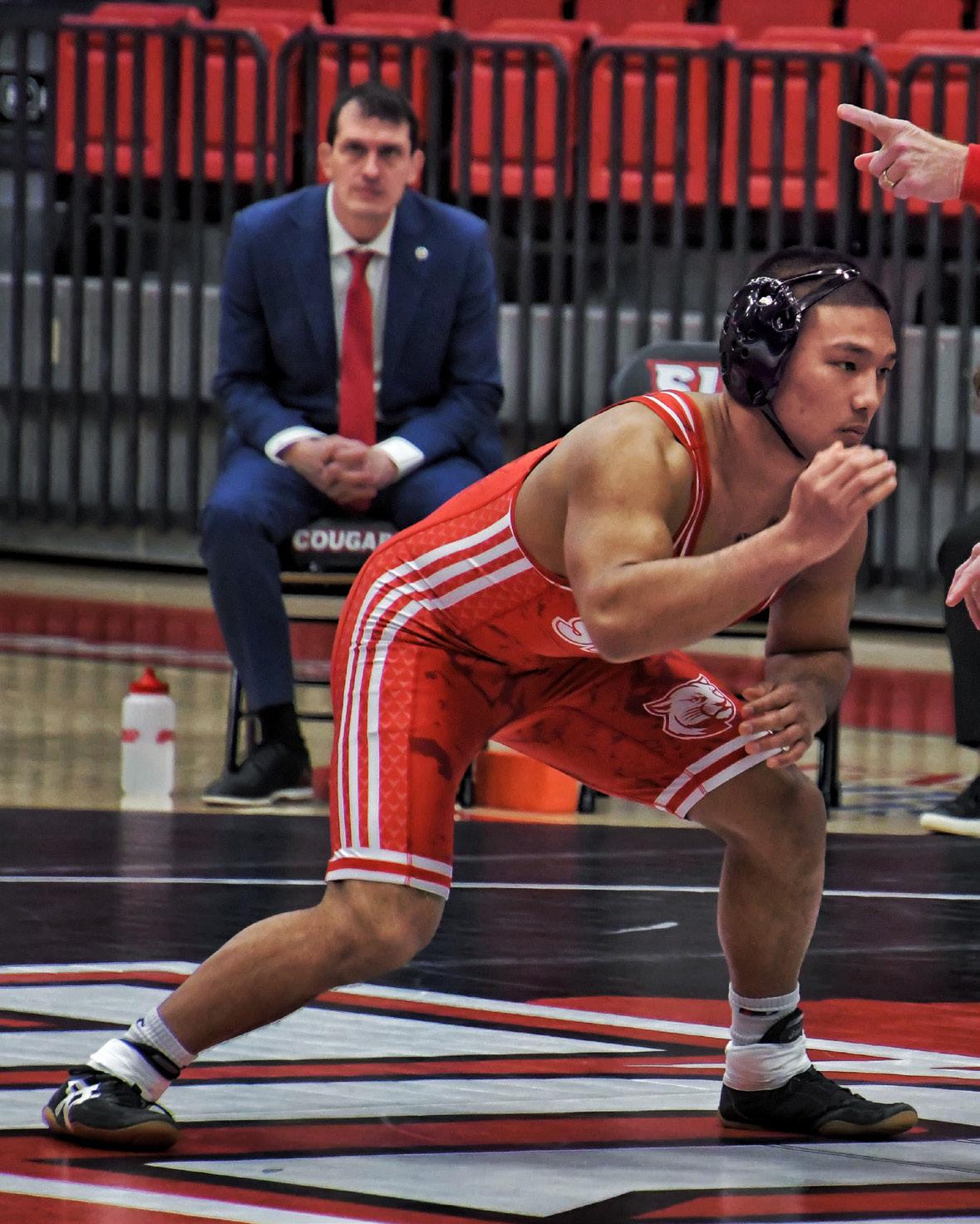
much different.”
Both the players and Thomas will have the entirety of this season to acclimate to the change after the announcement. The announcement video shared by SIUE Athletics on Instagram showed Thomas and the team’s reaction to the news.
“It was funny, because, as I told [the team], ‘I was driving in, and I knew what was about to take place, and I almost started crying,’ and then I took a second —
and then I started crying,” Thomas said. “To get the reaction [from the team] we got was pretty special.”
Thomas said the emotions were a build-up from the years of preparing for this moment.
“It’s just all been culminating and knowing this is home, this is real and it’s finally here,” Thomas said.
Wrestling will begin training tomorrow to prepare for their upcoming season, which has not yet been announced.
Volleyball takes first OVC loss against WIU
MATTHEW WOLDEN copy editor
Despite a victory against Western Illinois University the day before, volleyball took a loss in the second match-up against the team on Saturday.
“We’re not super happy,” head coach Kendall Paulus said. “We know we are better than that, and I don’t think we performed at our best.”
SIUE had three wins against Ohio Valley Conference opponents before Saturday’s match.
Saturday’s game started off close with a constant back-and-forth between the Cougars and the Leathernecks.
The first set of the game had a score of 24-22 before WIU made a comeback of 4 points, ending with a kill from the Leathernecks graduate outside hitter Keyana Cruse getting WIU the win for the set, 24-26. After the first set, SIUE gained momentum and made some significant plays.
It started off with a lead for WIU that lasted until a kill from sophomore outside hitter Teagan Sullivan
pushed the score to 9-8. For the rest of the set, the Leathernecks were unable to retake a lead, allowing the Cougars to take set two, 25-15.
The third set, similarly to the first set, was a close game.
Toward the end, the Leathernecks held the lead with a score of 22-24. SIUE was able to close the gap and get two points with a kill from junior middle blocker Vienna Elliott and a kill from Sullivan.
However, the Cougars failed to capitalize on the momentum, and the Leathernecks pulled ahead and
won the third set, 24-26. In the fourth set, the Cougars started to slow down. While there was still major push back on both sides, the Cougars never managed to gain a lead and at most tied the score with the Leathernecks. The Leathernecks kept up the pressure and won the set, 22-25.
“Even when we were winning, it wasn’t pretty volleyball across the board,” Paulus said. “I just felt like it was 50/50 … and we just can’t get any momentum that way.”
Despite the loss, Elliott is still certain the
team can get a good standing in the OVC and have a strong season.
“Not our best volleyball, but we definitely have a good upside for the rest of the season,” Elliott said. “I think we will beat a lot more teams in the OVC and have a good ranking at the end.”
“We did a lot of good things, but honestly, I feel like we have a lot to work on, a lot to clean up,” Elliott said.
SIUE will face University of Arkansas at Little Rock at 6 p.m. tomorrow at First Community Arena.
Cougars take CHARGE...
Men’s soccer ends losing streak in match up against EIU
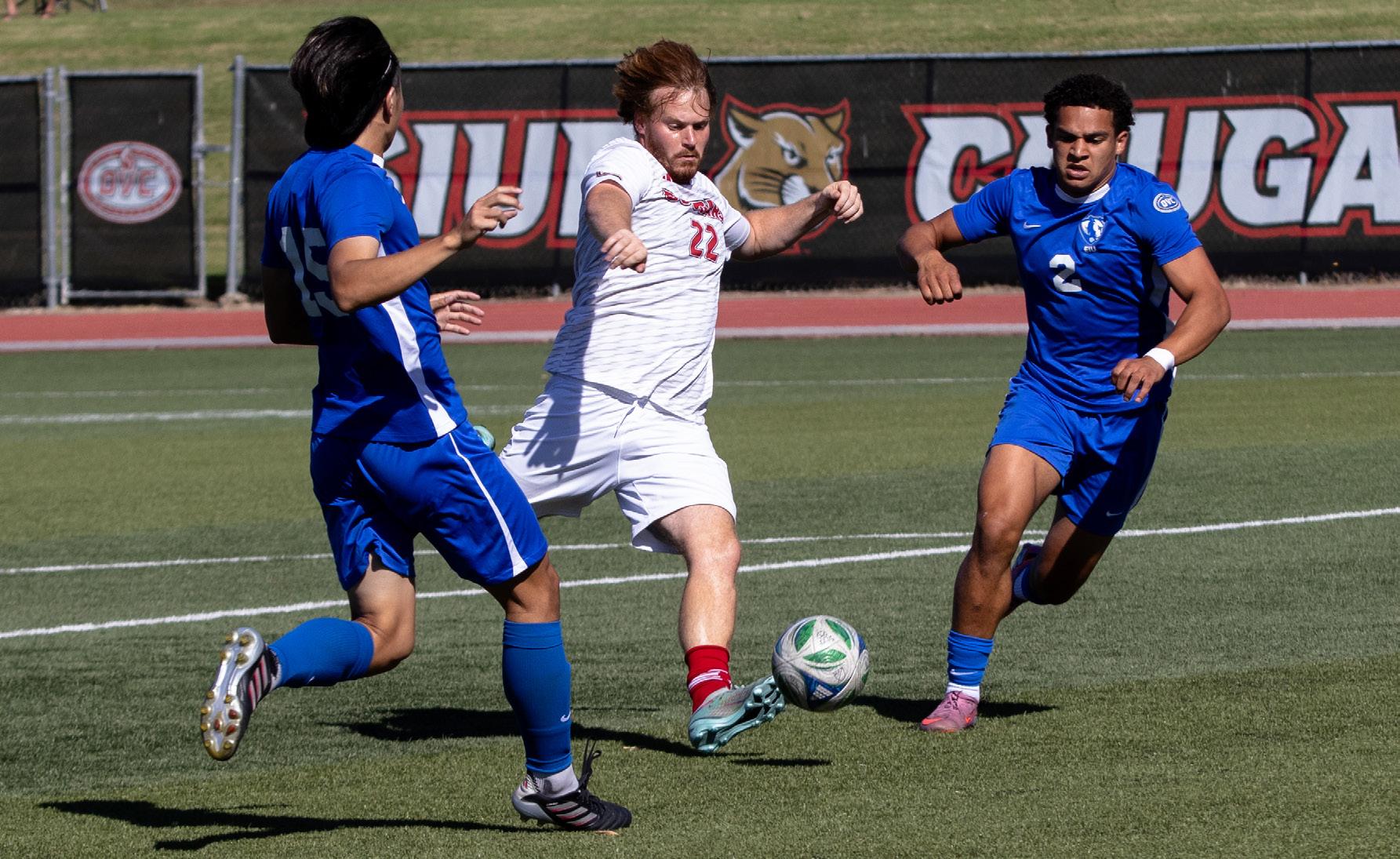
AUDREY O’RENIC sports editor
After a seven-game losing streak, men’s soccer took home a win in a 1-0 shutout against Eastern Illinois University on Sunday.
Head coach Cale Wassermann said the team suffered a disconnect after last season.
“We have a lot of new guys, and we had to rebuild the team a bit, so there was some tension [between players], and we had some losses,” Wassermann said.
The sole goal of the match came just over eight minutes in. After a foul on EIU, senior forward Evan Howard knocked a penalty kick into the bottom left of the goal.
“If there’s a chance in front of the goal, [Howard has] got a great chance to score,” Wassermann said.
Freshman goalkeeper Noah Scheidweiler secured his first clean sheet of the season.
“He’s got great potential, and he’s honestly one of the more talented goalies in the country for a freshman,” Wassermann said. Wassermann said the team’s new sense of connection was a key factor in their victory.
“[The team’s] attitude and culture is what has us hopefully starting a little streak here of wins,” Wassermann said.
The Cougars will travel to Missouri for a rematch against Lindenwood University at 7 p.m. tonight.
Softball defeats East Central in last home game of fall
Softball beat East Central College 14-0 in their last home game of the fall offseason on Sunday at Cougar Field.
The Cougars laid down a sturdy defense in the first inning that remained intact throughout the whole game, delivering three outs to the East Central Falcons’ first three batters.
“We work a lot on team defense in practice, so it’s really fun to play in the games and succeed and know that our hard work and practice is paying off in the games too,” freshman infielder Jesslyn Stairs said.
After a walk, sophomore infielder Juztyne Torres found a crack in the Falcons’ defense and scored the Cougars’ first run.
“We’re not there yet,” Falcons head coach Grant Young said to his team’s batters from the sidelines.
Stairs set up a fierce offense with a double to start the bottom of the fourth inning. A hit by freshman outfielder Elle van Bruesegen allowed Stairs to run home, and sophomore catcher Aidyn Barrera hit a triple that gave the Cougars two more runs.
“I knew that if I could start off the inning and get on base, we had a good chance
of scoring some more runs,” Stairs said.
Torres hit a single, then stole second base while senior outfielder Kaylin Fahy was at bat. Fahy hit a single that drove Torres home, putting the score at 6-0 by the end of the fourth inning.
“My second at-bat, there was a runner in scoring position, and I let the team down by striking out,” Torres said. “It really upset me. I could have done better, so I was just really locked in [after that].”
The Cougars pounced again in the sixth inning. After Torres hit a triple and they scored three more runs, the bases were loaded and senior
outfielder Gretchen Trello was up to bat. The Falcons called a timeout, and SIUE head coach Ben Sorden conferred with the players.
“I just told Gretchen [Trello] we needed a base hit here, and we didn’t need anything too big,” Sorden said.
Trello’s hit gave the Cougars another run, putting the score at 10-0 by the end of the sixth inning. The team scored three more runs in the tenth, putting the final score at 14-0.
“[We had] 12 strikeouts, which was good,” Sorden said. “The ball was moving well.”
With the fall presea-
son coming to an end, the team is turning its focus to spring competition.
“Our team is really ready to compete this year,” Stairs said. “We’re a really young team, so there’s a lot of growth that we’re capable of. I’m excited to see how far we get this year and how much growth we have.”
Sorden said the team is growing closer and is a lot of fun to coach.
“It’s always fun to see what they can do,” Sorden said.
SIUE will play the University of Missouri at 6 p.m. on Oct. 10 at the Mizzou Softball Stadium in Columbia, Missouri.
Women’s soccer captures first OVC victory against WIU
DESTINY ALBERCHT copy editor
Women’s soccer took their first Ohio Valley Conference win over Western Illinois University 3-2 last Sunday.
From kickoff, the Cougars displayed an offensive energy, out-shooting Western Illinois 17–9 and keeping consistent pressure on the Leathernecks’ back line.
“I think we were a little bit more aggressive offensively, which is what we needed,” Burton said. “I think that’s the most shots we’ve had in a game this year so far, so [I’m] super happy to see that.”
Senior forward Savannah DeFini set the tone early, giving SIUE the lead at the 17-minute mark with her team-leading third goal of the season. Coming from the right side of the box, DeFini launched a shot that bounced off the opposing goalkeeper’s hands
and right into the net.
The Leathernecks found their rhythm soon after, breaking through the Cougars’ defense and slipping the ball past junior goalkeeper Sarah Bozeman to tie it up 1–1.
SIUE responded quickly, though, reclaiming the lead. Senior midfielder, who doubles as a forward as well, Aleah Minehart weaved past two defenders in the box before sending a low shot into the left side of the goal to put the Cougars ahead 2–1.
The game-winning goal came at the 59-minute mark when freshman midfielder Claire Nieroda was fouled just outside the box.
Nieroda stepped up for the free kick and confidently buried the ball to the left of Leathernecks’ goalie. The goal also marked Nieroda’s first career score as a Cougar.
Bozeman anchored the defense with three saves, helping
SIUE secure the win.
Burton said the team’s growth is still a work in progress, especially when it comes to maintaining control under pressure as an emerging group.
“[Something we struggled with] is staying composed,” Burton said. “We have a young team that’s still learning to play the game the right way, so our composure with the ball needs to continue to get better.”
Freshman defense Zoe Bumiller said that the team’s execution can continue to improve.
“As a team, I think we put all of our effort in, but I think we could have, as a collective, put out our game plan a little better,” Bumiller said, adding that the Cougars need to focus more on “just finishing on goal.”
The Cougars’ victory improves their OVC record to 1-21. Their next game is at 7 p.m. tonight at Ralph Korte Stadium against the Lindenwood Lions.
